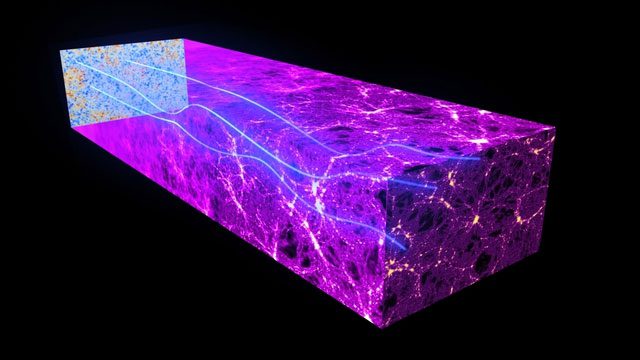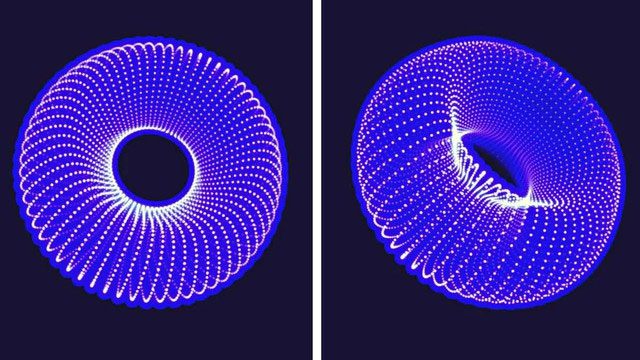What is the shape of the universe? This is an ancient yet intriguing question that pertains to our knowledge and understanding of the universe, as well as our position and significance within it.
Since humans began contemplating their existence and their surroundings, they have been curious about and explored the shape of the universe. Different civilizations and eras have provided various answers. In ancient times, people often believed that the universe was a binary structure consisting of heaven and earth. The sky was thought to be a rounded dome, while the earth was envisioned as a square platform, supported by several columns or peaks. These cosmological models can only be seen as human imagination from a mythical era and do not withstand rigorous scrutiny.

In ancient times, it was believed that the sky was a rounded dome and the Earth was a square platform. (Illustrative image).
With advancements in science and technology and increasingly deep explorations, we have more clues and evidence about the shape of the universe, but we also have more questions and confusions.
According to Einstein’s general theory of relativity, the shape of the universe depends on its density and curvature, which can be flat, open, or closed. Recent observational data indicates that the density of the universe is very close to the critical density, implying that the shape of the universe is very close to flat. However, this does not exclude the possibility that the universe’s shape may differ, such as a flat multi-connected space, resembling a three-dimensional donut.
This means that if we continue to travel in one direction, we will eventually return to our starting point, much like on a giant tire. If the universe is indeed a donut, what kind of strange sight would we encounter?

According to general relativity, the shape of the universe depends on its density and curvature. (Illustrative image).
What is the shape of the universe? First, we need to understand a concept known as the flatness of the universe.
The flatness of the universe refers to the geometric properties of the universe, specifically whether space in the universe is Euclidean space, which is the flat space we are familiar with.
In Euclidean space, parallel lines never intersect, and the sum of the interior angles of a triangle equals 180 degrees. If the universe is flat, it is Euclidean space. If the universe is not flat, it is a non-flat space—a curved space. In curved space, parallel lines may intersect, and the sum of the interior angles of a triangle may be greater or less than 180 degrees.
So how do we determine whether the universe is flat or not? There is a simple method to observe light in the universe. Light is an electromagnetic wave that travels at a constant speed in a vacuum and always follows the shortest path, known as a geodesic.
- If the universe is flat, geodesics are straight lines, and light will always travel in straight lines without bending.
- If the universe is not flat, geodesics will be curved, and light will bend into curves in space. Thus, by observing the bending of light, we can determine the flatness of the universe.

Albert Einstein.
So what type of light do we use for observation? The best choice is the cosmic microwave background radiation, the oldest light remaining from the Big Bang. This light covers almost the entire universe, serving as indicators of the thermodynamic temperature of the universe and witnesses to its structure and evolution.
Through precise measurements of the cosmic microwave background radiation, we can obtain several key parameters of the universe, such as its age, density, composition, and flatness.
According to data scanned by the Planck satellite from the European Space Agency in 2018, the universe is generally very flat but still has slight tilts and ripples. Overall, within the accessible range of the universe, parallel lines do not intersect, and the sum of the interior angles of triangles can still equal 180 degrees.
This implies that the geometry of the universe may be an infinitely extended plane, which is Euclidean space. However, this is not the only possibility, as there is also a special curved space that appears locally flat but is globally closed. Topological space is space derived by twisting and gluing space, whose properties do not depend on the size and shape of the space but rather on its connectivity and the number of holes within it. There are many types of topological spaces, one of which is the familiar donut or tire. A donut is a space with a hole that can be obtained by twisting and gluing a flat surface.

There are many types of topological spaces, one of which is the donut or tire. (Illustrative image).
Specifically, it involves gluing two opposite sides of a flat surface to form a cylinder, and then gluing the two circular ends of the cylinder to create a donut shape. In this way, an infinite plane becomes a finite donut, but at any point on the donut. Therefore, the donut is a locally flat space but globally closed.
So is the universe a donut? There is still no definitive answer to this question, but there are some clues and evidence. The most direct clue is the light from the universe’s beginning, which is the cosmic microwave background radiation. If the universe is a donut, then light within the universe would continuously circle around the donut, creating multiple overlapping images. These images are like the fingerprints of the universe and can be found in the temperature chart of the cosmic microwave background radiation.
Specifically, it involves searching for certain patterns on the temperature distribution map, such as rings, dots, or other symmetrical shapes. These patterns are topological features of the universe and reflect its shape and size.

The observable universe we can see is just a small part of the donut. (Illustrative image).
According to analyses by some scientists, there are indeed several topological features that may exist in the temperature distribution map of cosmic microwave background radiation. For instance, there is a method called “ring statistics”, which seeks similar rings on the temperature distribution map, where their radius and temperature are the same, but their positions differ.
Using this method, some estimate the radius of the universe to be around 300-400 billion light-years. The observable universe we can see is just a small part of the donut, with the remainder limited by the speed of light and belonging to the “cosmic fog” that astronomers cannot observe.
Of course, this estimate is uncertain and contains many inaccuracies. Due to the imperfect temperature distribution map of the cosmic microwave background radiation, it is affected by noise from various factors. For example, dust, galaxies, galaxy clusters, and other matter in the universe can also exert additional effects on cosmic microwave background radiation, causing the temperature distribution map to become blurred and complex, thereby obscuring the interconnected structure of the universe.

There is still no definitive answer to the question: “Is the universe a donut?”. (Illustrative image).
Therefore, more data and analysis are needed to find the donut shape of the universe from the temperature distribution map of cosmic microwave background radiation. So what does the donut shape of the universe mean for us?
Firstly, it means that the universe is a finite space; it does not expand infinitely. This imposes a limit on our exploration of the universe; we can never see the entire universe and will never know the full truth of the universe.
Monday, it means that the universe is a cyclical space; it is not a one-time event. This creates a cycle of evolution for the universe, which can continuously transition between expansion and contraction or shift between different shapes, like toroidal forms. Ultimately, this implies that the universe is a diverse space; it is not unique. This brings forth the possibility of the universe’s existence, suggesting that it may not be isolated but rather connected to other universes, forming a multiverse.


















































